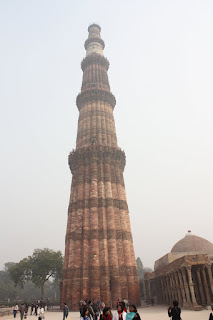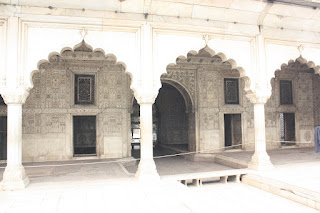Thanks for your support - You are all appreciated!

 (Jan 21-24) SPRING FEST
(Jan 21-24) SPRING FEST
 (Jan 22) Here is a typical (perfect) meal: on the far left, butter fry dal (I think the "butter" is ghee); to the right, makhan wala paneer, which has the characteristic homemade cheese chunks in a spicy tomatoey sauce; in the foreground, naan bread; and a Pepsi. I can't begin to tell you how tasty all of this is. Here are also a couple of views of a typical campus restaurant. All are out in the open. It hasn't rained at all since I have been in India.
(Jan 22) Here is a typical (perfect) meal: on the far left, butter fry dal (I think the "butter" is ghee); to the right, makhan wala paneer, which has the characteristic homemade cheese chunks in a spicy tomatoey sauce; in the foreground, naan bread; and a Pepsi. I can't begin to tell you how tasty all of this is. Here are also a couple of views of a typical campus restaurant. All are out in the open. It hasn't rained at all since I have been in India. (Jan 21) This evening I had an informal meeting with some of the Research Scholars (doctoral students) in Humanities and Social Sciences. What a delightful group of students. After saying a bit about my background, I asked them to each ask a question - personal or academic. Questions included: Is there localization in brain functioning? How do I prepare students for research? Can we effectively transform qualitative research into a quantitative format? What were my thoughts about taking patients into their future life through hypnotherapy? Our meeting lasted over an hour and it was one of the most enjoyable things I have done so far in India!
(Jan 21) This evening I had an informal meeting with some of the Research Scholars (doctoral students) in Humanities and Social Sciences. What a delightful group of students. After saying a bit about my background, I asked them to each ask a question - personal or academic. Questions included: Is there localization in brain functioning? How do I prepare students for research? Can we effectively transform qualitative research into a quantitative format? What were my thoughts about taking patients into their future life through hypnotherapy? Our meeting lasted over an hour and it was one of the most enjoyable things I have done so far in India! Today I was graciously invited to my sponsor's home to celebrate a "puja," that is a worship, of the goddess Saraswati Panchami, the goddess of education and learning. This is not the biggest puja in the Hindi calendar, but certainly apropos for the students and faculty of the Institute. To celebrate, we had special Indian dishes. I can't possibly say what they are called, but they included many fruits and a rice dessert, and were quite delicious! The pictures show a special altar before which my sponsor and wife pray daily, as well as a larger altar in the living room.
Today I was graciously invited to my sponsor's home to celebrate a "puja," that is a worship, of the goddess Saraswati Panchami, the goddess of education and learning. This is not the biggest puja in the Hindi calendar, but certainly apropos for the students and faculty of the Institute. To celebrate, we had special Indian dishes. I can't possibly say what they are called, but they included many fruits and a rice dessert, and were quite delicious! The pictures show a special altar before which my sponsor and wife pray daily, as well as a larger altar in the living room. (Jan. 14) This is Howrah Station, the main rail terminal for Kolkata (Calcutta). It is across the river from Kolkata because at the time it was built, the British had not yet constructed a bridge across the river. The current Howrah bridge is the second largest cantilever bridge in the world. I came to Kolkata to visit the USIEF (Fulbright-Nehru) office, which is in the American Center. Because of security restrictions, I could not take photos at the American Center. It is one of the few places in India where you can find side-by-side framed pictures of Biden, Obama, and H. Clinton (very heartwarming for someone away from home).
(Jan. 14) This is Howrah Station, the main rail terminal for Kolkata (Calcutta). It is across the river from Kolkata because at the time it was built, the British had not yet constructed a bridge across the river. The current Howrah bridge is the second largest cantilever bridge in the world. I came to Kolkata to visit the USIEF (Fulbright-Nehru) office, which is in the American Center. Because of security restrictions, I could not take photos at the American Center. It is one of the few places in India where you can find side-by-side framed pictures of Biden, Obama, and H. Clinton (very heartwarming for someone away from home).
 (Jan. 7) This is the Qutb Minar in Delhi. It should qualify as a wonder of the world. It stands 72 m and is constructed from red sandstone and marble in a lock-and-key construction. It actually has a stairway to the top! To the right, in the image above, you will see the first mosque built in India. Through additional construction, the Qutb Minar was surrounded with additions and extensions to the mosque. Our guide pointed out the qualitatively different nature and quality of construction of the Qutb Minar and surrounding buildings. The Qubt Minar (minaret) has few of the architectural features of a true minaret, leading to the suggestion (not to be found in the official guidebook) that the Qutb Minar was built by Indian scientists prior to the arrival of Islam to India.
(Jan. 7) This is the Qutb Minar in Delhi. It should qualify as a wonder of the world. It stands 72 m and is constructed from red sandstone and marble in a lock-and-key construction. It actually has a stairway to the top! To the right, in the image above, you will see the first mosque built in India. Through additional construction, the Qutb Minar was surrounded with additions and extensions to the mosque. Our guide pointed out the qualitatively different nature and quality of construction of the Qutb Minar and surrounding buildings. The Qubt Minar (minaret) has few of the architectural features of a true minaret, leading to the suggestion (not to be found in the official guidebook) that the Qutb Minar was built by Indian scientists prior to the arrival of Islam to India.
 (Jan. 7). The Qutb Minar complex was built on the site of a Hindu temple. Materials and artwork of Hindu and Jain origin are evident in the Afghan architecture. In the image above is an iron pillar that preceded construction of the mosque complex. The pillar may date from 375 A.D. It is so pure that it has not rusted in 1500 years. Belief has it that if you stand with your back against the pillar and wrap your arms around it, your wish will be granted. Unfortunately, my wish was denied, as the pillar has been roped off in recent times.
(Jan. 7). The Qutb Minar complex was built on the site of a Hindu temple. Materials and artwork of Hindu and Jain origin are evident in the Afghan architecture. In the image above is an iron pillar that preceded construction of the mosque complex. The pillar may date from 375 A.D. It is so pure that it has not rusted in 1500 years. Belief has it that if you stand with your back against the pillar and wrap your arms around it, your wish will be granted. Unfortunately, my wish was denied, as the pillar has been roped off in recent times. (Jan. 6) This is a view of Red Fort from a distance. This site is popular with visitors to Delhi and with residents as well. While walking through, we observed schoolchildren on field trips. Notable was a display of watercolor and line drawings of indigenous individuals who lost their lives in the Uprising of 1857. Below is an intricate metal door, typical of the craftsmanship found throughout Old Fort. Also, a direct shot of the sun through the thick city air.
(Jan. 6) This is a view of Red Fort from a distance. This site is popular with visitors to Delhi and with residents as well. While walking through, we observed schoolchildren on field trips. Notable was a display of watercolor and line drawings of indigenous individuals who lost their lives in the Uprising of 1857. Below is an intricate metal door, typical of the craftsmanship found throughout Old Fort. Also, a direct shot of the sun through the thick city air.
 (Jan. 6) This is the massive entry way to Red Fort. Remants of a moat that surrounded the fort are still evident. Red Fort is left from the Mughal Empire (approx. 1500 and beyond). The founder of the Mughal line was Babur, a descendant of Ghenghis Khan.
(Jan. 6) This is the massive entry way to Red Fort. Remants of a moat that surrounded the fort are still evident. Red Fort is left from the Mughal Empire (approx. 1500 and beyond). The founder of the Mughal line was Babur, a descendant of Ghenghis Khan. These are buildings that you will find behind the walls of Red Fort. It is a fantasy land, with baths, fountains, temples, and royal quarters.
These are buildings that you will find behind the walls of Red Fort. It is a fantasy land, with baths, fountains, temples, and royal quarters.